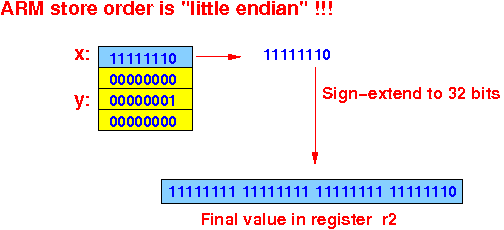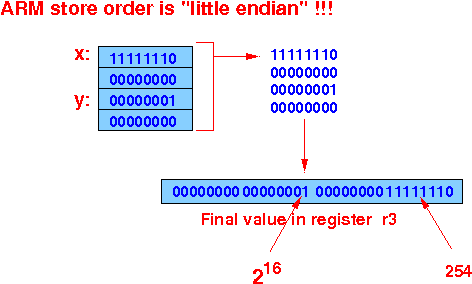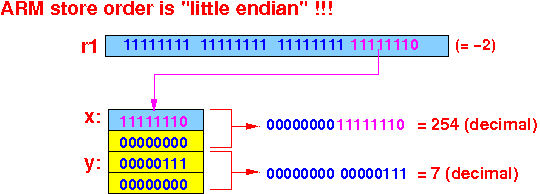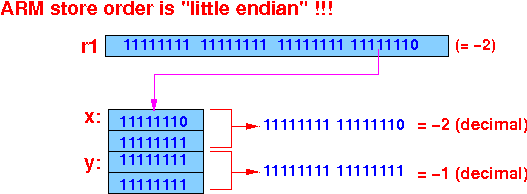- Warning:
- You must use
the correct
load and
store instructions to
tranfer data in
the (memory) variables to
the registers inside the CPU !!!
Use When the data type of the variable is ------------ ------------------------------------------ ldrsb/strb byte ldrsh/strh short ldr /str int - Your program will contain a bug (= program error) if you use an incorrect load/store instruction
In this webpage, I will show you what will happen when you use an incorrect load/store instruction (and quiz you if you can understand the cause of the error)
- You must use
the correct
load and
store instructions to
tranfer data in
the (memory) variables to
the registers inside the CPU !!!
- Fact:
- A computer is a
machine that
does exactly what
it is
told to do
In other words:
- A computer
cannot
think !!
(Well, you may have head about Artificial Intelligence, that's not the computer. AI is a very large computer program that examines a lot of data using a computer - the computer itself is not intelligent)
A computer is just as dumb as a door nail !!!
- A computer
cannot
think !!
- A computer is a
machine that
does exactly what
it is
told to do
-
We have learned what the
load instructions do:
Syntax and meaning of the basic form of the load register instruction is:
Syntax Meaning of the instruction ---------------- -------------------------------------------------- ldr rN, [rM] Load 4 bytes from memory at the address given in rM into the (destination) register rN The 4 bytes are stored in the register as follows: |
Let's see how well you can apply your understanding...
- A program contains
2 short variables x and
y stored as follows:

In the following program, I transfer the value stored at the memory location x: into the registers using 3 different load instruction:
main: // short x contains 254 = 0000000011111110 movw r0, #:lower16:x // Moves the address of memory movt r0, #:upper16:x // variable x into register r0 // Move short x into r1 using ldrsh (correct !) ldrsh r1,[r0] // r1 = 254, correct // Move short x into r2 using ldrsb (wrong value !) ldrsb r2,[r0] // r2 = -1, WRONG !! // Can you explain why r2 contains -1 ? // Move short x into r3 using ldr (wrong value !) ldr r3,[r0] // r2 = 65790 = 216 + 254, WRONG !! // Can you explain why r2 contains 216 + 254 ? /* -------------------------------------------------- Begin of the permanent program variables -------------------------------------------------- */ .data x: .2byte 254 // short typed variable y: .2byte 1 // short typed variable .endThe ldrsh instruction will transfer the correct value (254) into the register r1
But::
- The ldrsb instruction stores a wrong value −2
- The ldr instruction stores a wrong value 65790
Can you explain why using what you know about these instructions (see above) ???
- Example Program:
(Demo above code)

- Prog file: /home/cs255001/demo/asm/2-mov/wrong-ldr.s
How to run the program:
- To compile: as255 wrong-ldr
- To run: use EGTAPI
- Why does
the ldrsb instruction
store −2 into
a register:
- The ldrsb instruction
will load a
byte from
memory location
x: and
sign-extend the
byte
into 32 bits:

So the register will contain the 2s complement code 11111111111111111111111111111110 which represents the value −2 !!!
- The ldrsb instruction
will load a
byte from
memory location
x: and
sign-extend the
byte
into 32 bits:
- Why does
the ldr instruction
store 65790 = 216 + 254 into
a register:
- The ldr instruction
will load a
int (= 4 bytes) from
memory location
x: which will
read too many bytes:

The ldr instructions has also read the bytes from the variable y into the register !!!
So the register will contain the 2s complement code 00000000000000010000000011111110 which represents the value 216+254 = 65790 !!!
- The ldr instruction
will load a
int (= 4 bytes) from
memory location
x: which will
read too many bytes:
-
We have learned what the
store instructions do:
Syntax and meaning of the
basic form of
the store register instruction
Let's see
how well you can
apply your understanding...
Syntax Meaning of the instruction
---------------- --------------------------------------------------
str rN, [rM] Store 4 bytes from register rN to memory (consecutively) at
the address given in register rM
The 4 bytes are taken from the register as follows:
 strh rN, [rM] Store 2 bytes from register rN to memory (consecutively) at
the address given in register rM
The 2 bytes are taken from the register as follows:
strh rN, [rM] Store 2 bytes from register rN to memory (consecutively) at
the address given in register rM
The 2 bytes are taken from the register as follows:
 strb rN, [rM] Store 1 byte from register rN to memory (consecutively) at
the address given in register rM
The byte is taken from the register as follows:
strb rN, [rM] Store 1 byte from register rN to memory (consecutively) at
the address given in register rM
The byte is taken from the register as follows:

- The next program contains the following
2 short variables x and
y:

In the main( ) method, I will update the memory variable at the memory location x: with the value -2 (stored in the register r1) using 3 different store instructions:
main: movw r0, #:lower16:x // Moves the address of memory movt r0, #:upper16:x // variable x into register r0 mov r1, #-2 // Move -2 into short var x (correct !) strh r1,[r0] // x = -2, correct // Change strh to strb and you will get x = 254 !! // Can you explain why x contains 254 ? // Change strh to str and you will update y = -1 !! // Can you explain why y gets updated to -1 ? /* -------------------------------------------------- Begin of the permanent program variables -------------------------------------------------- */ .data x: .2byte 4 // a short typed variable y: .2byte 7 // a short typed variable .endYou need to edit the program and recompile and run again to see the following results:
- The strh instruction will
update the
variable x with the
correct value -2
and does
not mistakenly update
other variable
- But::
- The strb instruction stores a wrong value 254 in the variable x
- The str instruction will also update another variable y (sets the variable y = -1 !!!)
Can you explain why using what you know about these store instructions (see above) ???
- The strh instruction will
update the
variable x with the
correct value -2
and does
not mistakenly update
other variable
- Example Program:
(Demo above code)

- Prog file: /home/cs255001/demo/asm/2-mov/wrong-str.s
How to run the program:
- To compile: as255 wrong-str
- To run: use EGTAPI
- Why does
the strb instruction
store 254 into
the variable x:
- The strb instruction
will update a
byte value
in register r1
into the
memory location
x::

So the short typed memory variable x will contain the 2s complement code 0000000011111110 which represents the value 254 (decimal) !!!
- The strb instruction
will update a
byte value
in register r1
into the
memory location
x::
- Why does
the str instruction
also update the
variable y = -1:
- The str instruction
will transfer a
int (= 4 bytes) from
a register to the
memory location
x:.
The 4 bytes are stored in memory as follows:

So the str instructions has also updated the bytes of the variable y in the memory !!!
The short variable y will contain the 2s complement code 1111111111111111 which represents the value −1 !!!
- The str instruction
will transfer a
int (= 4 bytes) from
a register to the
memory location
x:.


